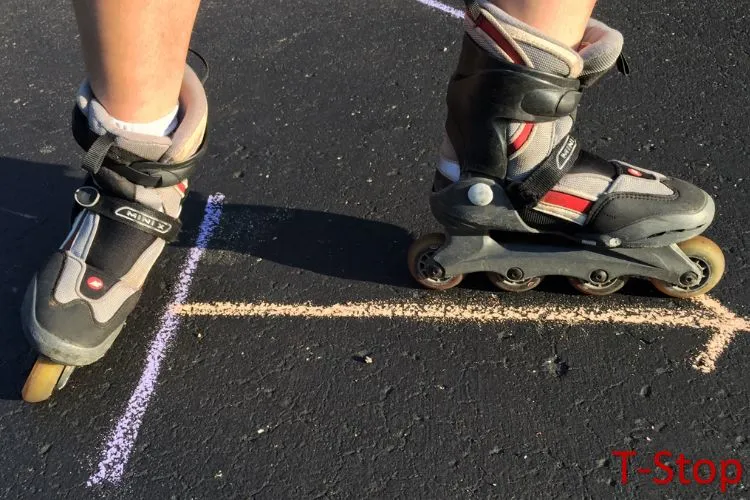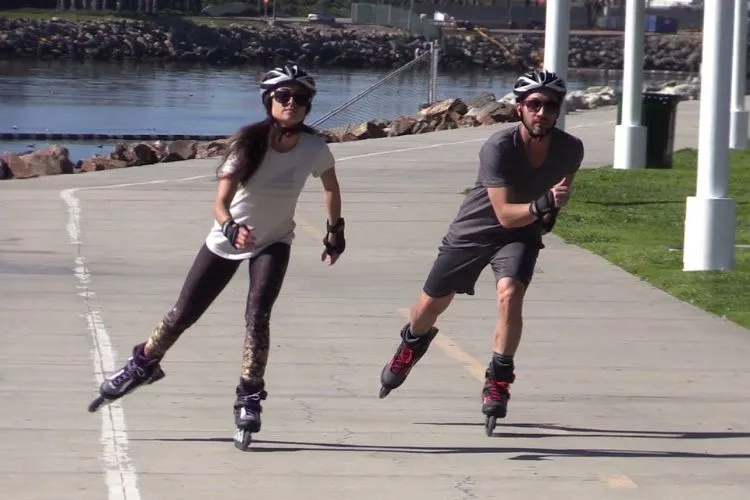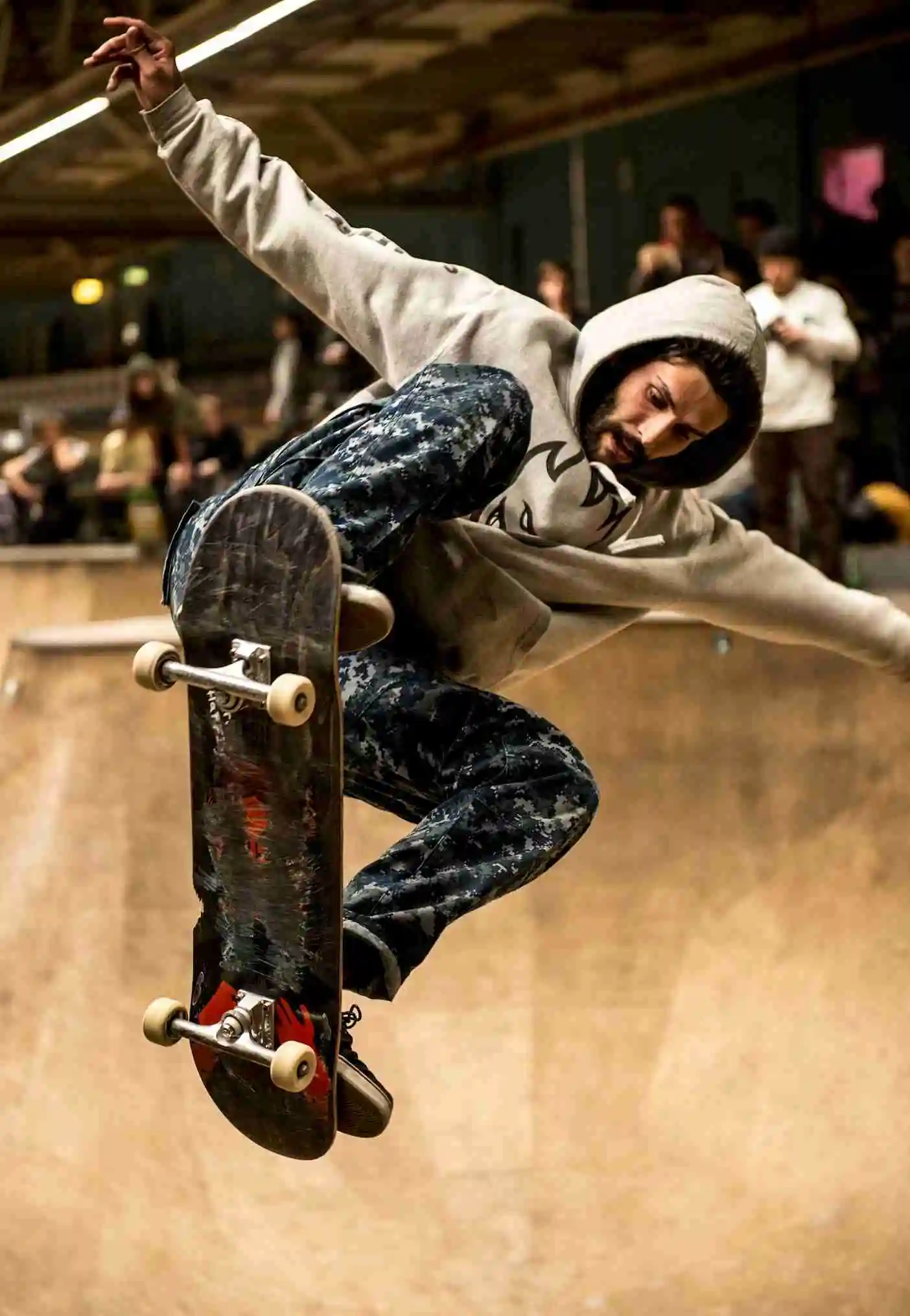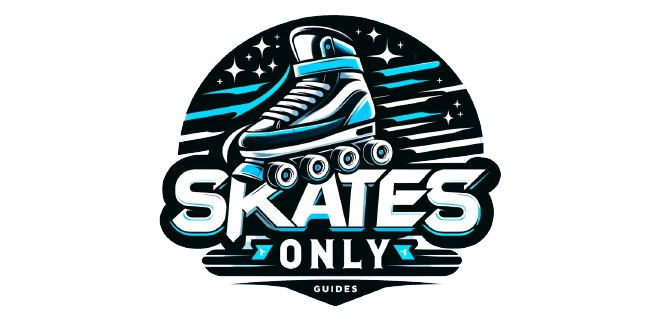Learning how to stop inline skates without a brake is not just a skill for advanced skaters. It’s vital for every skater. In this detailed guide, we’ll cover how to stop inline skates without a brake, ensuring your skating sessions are as safe as they are fun.

Why Master Stopping Without a Brake?
Inline skates often come with a built-in brake. However, depending on a brake alone has its limitations. There are various scenarios where you might find it useless, such as in wet conditions or during an unexpected need to halt.
Knowing different ways to stop adds to your skill set, making your skating experience safer and more versatile.
How to Stop Inline Skates Without A Brake?
Let’s dive into some of the most popular techniques for stopping inline skates without the reliance on a brake.
T-Stop / T-Slide
The T-Stop involves dragging one skate behind you to create friction, gradually bringing you to a stop. Start by skating forward at a comfortable pace. Place one foot behind you, perpendicular to your direction of travel.
Apply pressure to the back skate until you come to a complete stop. This method is ideal for controlled deceleration. Keep your knees slightly bent to maintain balance throughout the stop.
Plough Stop
Similar to skiing, the plough stop uses a V-shaped leg motion to slow down. Begin by skating at a moderate speed. Then, gradually spread your legs apart while angling the toes inward, creating a wedge shape.
The increased friction will help you slow down. This technique is best suited for beginners due to its stability and ease of execution.
Lunge Stop
The lunge stop requires a bit more skill and involves one leg being stretched forward while the other leg bends behind, resembling a lunge position.
This method effectively stops the skater but requires good balance and leg strength. Ensure you practice this in a controlled environment before attempting it at high speeds.
Turning to Stop (U-Turn)
Using turns to reduce speed and eventually stop is another effective method. By making a sharp turn or series of turns, you can lower your speed significantly. This technique is particularly useful in narrow or crowded spaces where other methods might not be as practical.
Advanced Techniques
For experienced skaters looking for a challenge, there are more complex stopping methods like the power slide and the magic slide. These techniques offer quick, effective stopping power but require a lot of practice and precision to master.
Safety Gear and Precautions
Ensuring your safety while inline skating is paramount, and the right gear plays a crucial role in protecting you from falls and collisions. No level of proficiency can eliminate the risk of accidents, so adherence to protective measures is non-negotiable. Consider the following essential safety gear:

- Helmets: The first line of defense against head injuries. Always choose a helmet that fits snugly and complies with safety standards.
- Knee Pads: Protect the knees from scrapes and impacts. Look for pads that offer both comfort and sturdy protection.
- Elbow Pads: Essential for safeguarding the elbows against harsh impacts. Ensure they fit well without limiting arm movement.
- Wrist Guards: Crucial for preventing wrist fractures and sprains by absorbing shock during falls.
Beyond gear, be mindful of skating in appropriate areas away from traffic and obstacles, and always check your equipment for wear and tear before skating. Staying visible with reflective clothing and practicing in a safe, open area are also key precautions.
You may also read: Is Inline Skating a Minority Sport? | Does Inline Skating Help with Skiing?
Practicing and Improving Your Stopping Skills
Practice is crucial when learning these techniques. Start in a safe, open area free from traffic and obstacles. Gradually build up your speed as you become more comfortable with each stopping method. Over time, you’ll gain confidence and skill, making you a safer, more competent skater.
Choosing the Right Skates for Brakeless Stopping
Selecting the appropriate inline skates is a critical factor in mastering brakeless stopping techniques. The design and quality of your skates can greatly affect your control and ability to perform advanced maneuvers safely. Consider these key factors:

- Wheel Hardness: Harder wheels, indicated by a higher durometer rating, offer less grip but more slide, aiding in techniques like the T-Stop or power slide. Softer wheels provide more grip, which can be beneficial for beginners mastering the plough stop.
- Bearing Quality: High-quality bearings ensure smoother rolling, which provides better control and stability. This is crucial for executing precise stopping maneuvers.
- Frame Type: The frame of your skates affects your balance and agility. A shorter frame offers more maneuverability, which is essential for quick stops and turns, while a longer frame provides stability at high speeds but might require more skill to stop effectively.
- Boot Support: Adequate ankle support is vital for any braking technique. A supportive boot helps maintain proper form and prevents injuries during sudden stops.
By selecting skates that align with these considerations, skaters can enhance their capability to perform brakeless stops more effectively and safely.
Frequently Asked Questions (FAQs)
How long does it take to master these stopping techniques?
It varies by individual, depending on your skating experience, balance, and how often you practice. Some may learn within a few days, while others may take weeks to feel confident.
Can I use these techniques on any terrain?
These techniques are best practiced on smooth, flat surfaces. Rough or uneven terrain can make stopping more challenging and may require additional skill and caution.
Are there any specific types of inline skates that are better for brakeless stopping?
While you can perform these techniques on any inline skates, those designed for freestyle or aggressive skating often offer better control and maneuverability for advanced stopping methods.
Conclusion
Mastering how to stop inline skates without a brake is essential for every skater. It not only enhances your safety but also improves your overall skating ability.
By learning and practicing the techniques outlined in this guide, you’ll become a more versatile and confident skater. Remember, the key to success is patience and consistent practice. Stay safe and enjoy the ride.

Matthew James is a passionate skater who wanted to create a platform to share his love for skating with others. With a vision to create a vibrant community of skaters, he aims to provide a space where skaters of all levels can connect, learn, and grow together.
